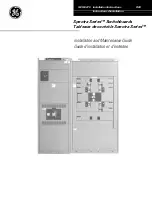
IB 6.1.12.1-1C
2
3
ABB
The overcurrent trip device trip travel is set at the
factory; however, if trip travel readjustment is required
due to replacement of the device or affected parts,
readjust as follows:
1. Reverse the two trip adjusting screws CCW until
the screws engage the nut by approximately two
revolutions.
2. Charge the closing springs and close the circuit
breaker.
3. Push up on the long-time armature (wide
armature) and seat it firmly against the magnet.
When pushing against the long-time armature,
allow time for oil in the dashpot to displace.
Keeping the armature seated against the magnet,
advance the screw CW until the circuit breaker
trips. Advance the screw one additional revolution
CW.
CAUTION
During this adjustment operation, hold the armature firmly
against the magnet, but do not exert excessive force that will
result in incorrect adjustment due to distortion.
4. Charge the closing springs and close the circuit
breaker. Push up on the thin armature and adjust
the screw using the same procedure as in step #3.
5. Readjust the trip travel for the other pole(s) as in
steps #1 through #4.
See Table B1 of Appendix B for applicable time-
current curves and reference to complete device
instruction and testing. Table A4 of Appendix A lists
all nameplate ratings available for each standard type
of OD device.
Solid-state Overcurrent Trip Device
No device adjustments are made on the Power Shield
trip device. Confirm settings and make certain that the
selector plugs are seated completely. Coordination
will be affected if a plug taps intermittently or is
missing since the device will default to the minimum
setting available.
WARNING
Do not disconnect the harness from the trip unit on a closed
breaker in service. Current transformers on the breaker poles
power the trip unit. Disconnecting the harness will produce
high voltage arcing due to the resulting open circuit condition
of the sensors. The breaker must be open before connecting or
disconnecting the trip unit harness, or otherwise de-energized.
See Table B2 of Appendix B for applicable time-
current curves and reference to complete device
instruction and testing.
Microelectronic Overcurrent Trip Device
No device adjustments are made on MPS, MPS-C, or
MPSC-2000 devices. Trip settings are set on the unit
and only need confirmation.
See Tables B3 and B4 of Appendix B for applicable
time-current curves and reference to complete device
instruction and testing.
WARNING
Do not disconnect the harness from the trip unit on an
energized breaker. Current transformers on the breaker poles
power the trip unit. Disconnecting the harness will produce
high voltage arcing due to the resulting open-circuit condition
of the sensors. The breaker must be open before connecting or
disconnecting the trip unit harness, or otherwise de-energized.
Operational Checks
Draw-out Shutter and Racking
Confirm that the interlocked shutter will not open for
handle insertion when the breaker is closed,
regardless of draw-out position. On an open breaker,
rack the breaker into each of the draw-out positions
and confirm that the shutter closes when the handle
is removed. Notice that the shutter does not close
between positions; the interlocking forces the
mechanism to be trip-free.
Auto Spring Discharge
Trip the breaker open. Place the breaker in the TEST
position. Charge the closing springs but do not close
the breaker. Rack the charged breaker into the
DISCONNECTED position. The springs should
discharge just before reaching DISCONNECTED.
Electrical Charging, Closing, and Opening
Confirm functional circuit breaker operation by
sequencing the breaker through the charge, close,
and open cycles. Test both electrical and manual
controls. Verify local and remote operation.
Trip-free Mechanism
Initiate breaker closure while maintaining a trip signal
(or depressing the local trip button). The mechanism
should trip-free rather than latch closed.
Anti-pump Circuit (EO)
This check verifies function of the lockout relay coil.
Test the anti-pump as follows:
1. Charge the breaker electrically.
2. Electrically close the breaker and maintain the
close signal.
3. While still maintaining the close signal, trip the
breaker open. The motor will recharge the
closing springs.
If the anti-pump lockout relay is functioning, the
breaker will not re-close (after the motor recharges
the closing springs) until the original close is
released and reissued.
Magnetic Latch Release
Verify device operation. The simplest way to test the
device is with secondary current injection to the trip










































